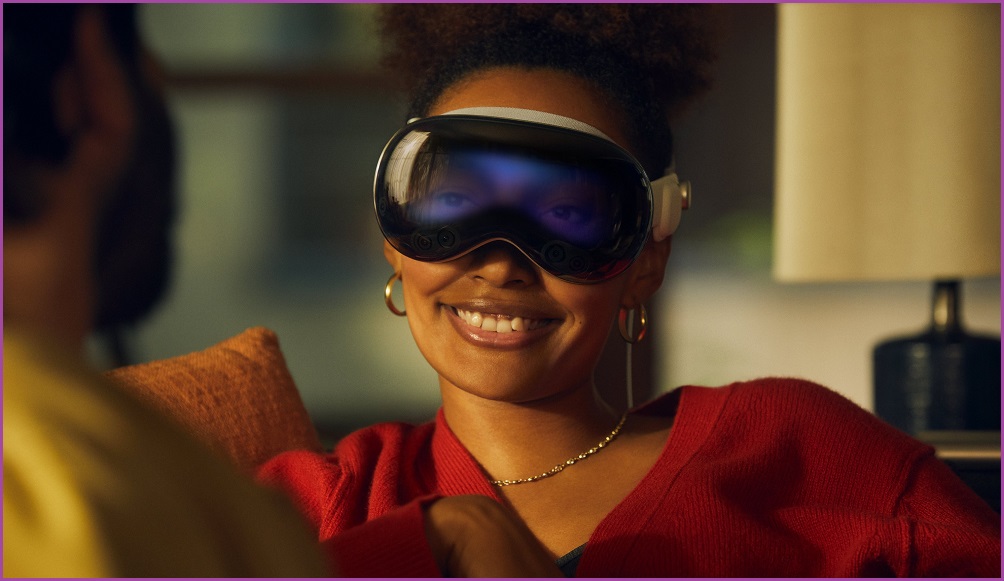Apple has stepped into the virtual and augmented reality market with its Vision Pro headset, an ambitious piece of hardware that will be released next year with a whopping US$3,499 (at least AUD$5,000) price tag.
Apple executives repeatedly referred to the device as “magic” during a 45-minute segment at the end of its Worldwide Developers Conference 2023 keynote presentation early on Tuesday morning Australian time.
“Vision Pro is a new kind of computer that augments reality by seamlessly blending the real world with the digital world,” Apple CEO Tim Cook said.
“It’s the first Apple product you look through, and not at. Vision Pro feels familiar yet it’s entirely new.
“You can see, hear, and interact with digital content just like it’s in your physical space. And you control Vision Pro using the most natural and intuitive tools – your eyes, hands, and voice.”
There are no controllers for the Vision Pro, just hand and eye-tracking done with the hardware’s external cameras and a set of sensors around the eye pieces.
Each of the two micro-OLED displays (one per eye) has a resolution higher than 4k, making it a standout in the consumer headset market.
People with glasses will need to buy prescription lenses that fit into the eye pieces.
The high resolution is important because the Vision Pro is designed to be worn around the house as its array of external cameras relay the outside world to the wearer.
The external cameras can also be used to take 3D photos and videos by pressing or holding a button on top of the headset.
There’s also a dial on the headset that lets users fade immersive environments, controlling how much of the outside they want to see.
Internal eye-tracking lets the headset know where you’re looking so it can highlight icons and buttons that you then click with a simple hand gesture, rather than the hand waving and pointing typically shown in augmented and virtual reality demos.
Welcome to the era of spatial computing with Apple Vision Pro. You’ve never seen anything like this before! pic.twitter.com/PEIxKNpXBs
— Tim Cook (@tim_cook) June 5, 2023
Hand tracking is a tricky design choice over controllers that tell headsets their precise location because it requires users’ hands to be in view of the camera array at all times during use.
On the outside is a display that shows a simulated version of the wearer’s eyes, a unique feature for this type of headset that will help other people make eye contact with the wearer and see when they’re interacting with a full virtual reality environment.
Apple largely showed off the Vision Pro as a way of filling your home and office with massive screens for productivity and entertainment.
Even its section about gaming was surprisingly mute on the virtual reality element – focusing instead on playing Apple Arcade games using a standard gaming controller, not walking around immersive virtual worlds.
This is a point of difference between the Apple Vision Pro and Meta’s line of Quest headsets. Last week, Meta announced its forthcoming Quest 3 alongside a gaming showcase – firmly positioning the headset as a gaming console.
Apple, on the other hand, is trying to sell the Vision Pro as a general computing platform. Its ultra-high-resolution displays are aimed to make every-day productivity tasks like reading, writing, and coding a viable option, offering a direct sync with Macs to act as an independent display.
Apple did not mention the metaverse.
The headset is driven by Apple’s M2, the proprietary chip used in its Macbooks, and the new R1 chip dedicated to processing data from the array of cameras, sensors, and microphones.
Power will be supplied externally in an effort to reduce the device’s weight and heat. An external battery pack will give it two hours of use, but the headset can run continuously if plugged into a direct power supply.
Headset wearers will be able to make video calls using FaceTime and other software (Teams, Zoom) using a realistic avatar created by scanning the user’s face. Eye and gesture tracking will be transposed onto the avatar to give a sense of presence.
The range of apps and experiences Apple showed off seemed pretty basic and rarely extended beyond larger screens in a headset, but with at least six months until release, it’s giving developers a headstart on populating the App Store.










